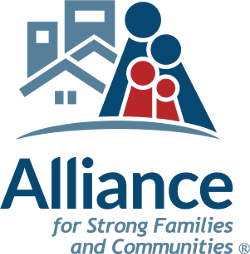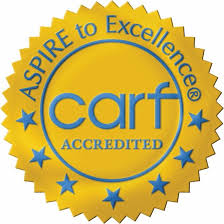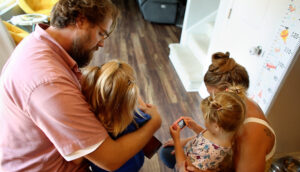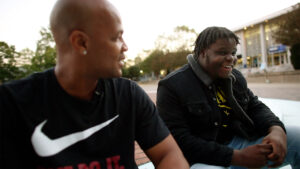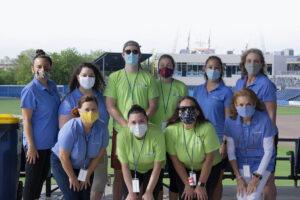During the month of April, the nation turns its attention to a pressing issue that affects countless children and families: child abuse. April is designated as Child Abuse Awareness Month, a time to reflect on our collective role in shielding children from harm and strengthening families to foster a thriving community.
At The Up Center, we’ve dedicated more than 140 years to protecting children and offering families the tools they need to succeed. Through initiatives like education, counseling, and intervention, we aim to inspire individuals to take action and prevent child abuse in their communities.
This blog will explore what child abuse is, the importance of recognizing the signs of child abuse, and actionable steps you can take to prevent abuse and support families.
What is Child Abuse?
Child abuse refers to any act of harm or neglect by a caretaker that endangers a child’s physical or emotional health. Broadly speaking, child abuse includes four main categories:
- Physical abuse: Inflicting physical harm, such as hitting or burning.
- Emotional abuse: Behaviors that harm a child’s self-esteem or emotional development, such as rejection or constant criticism.
- Sexual abuse: Any form of sexual interaction with a child.
- Neglect: The failure to provide for a child’s basic needs, such as food, shelter, or medical care.
Nearly one in seven children in the United States has experienced abuse or neglect in the past year, according to the U.S. Centers for Disease Control and Prevention. It’s important to remember that these occurrences are not bound by geography, socioeconomic status, or culture. Child abuse can and does happen in every community.
Recognizing the Signs of Child Abuse
Spotting the signs of child abuse is one of the most critical steps in safeguarding children. Here’s what to look for:
Physical Signs
- Unexplained injuries, such as bruises, burns, or fractures
- Signs of repeated harm, like frequent or patterned bruising
- Injuries inconsistent with explanations provided by the child or caretaker
Behavioral Signs
- Withdrawal from friends and family
- Uncharacteristic fearfulness or aggression
- Sudden changes in behavior or school performance
- Reluctance to go home
Emotional Signs
- Persistent feelings of sadness, low self-esteem, or hopelessness
- Anxiety or signs of depression
- Regression in developmental milestones, such as bed-wetting
Developmental Delays or Regression
- Speech, cognitive, or motor delays without any apparent medical reason
- Sudden loss of developmental skills the child had previously acquired
Recognizing these signs allows adults to intervene and ensure the safety and well-being of children at risk.
How to Prevent Child Abuse in Our Communities
Prevention is not just a possibility; it’s an essential, community-driven mission. By fostering strong relationships and providing resources, we can significantly reduce the risk of abuse.
Education and Awareness
Community education is a powerful tool in preventing abuse. Child abuse awareness campaigns, seminars, and parenting workshops equip caregivers with the knowledge they need to create safe and nurturing environments for children. At The Up Center, we actively promote parenting classes, emphasizing trauma-informed care.
Building Positive Relationships
A child’s sense of security starts with strong, positive connections. Adults can build these by actively listening to children, validating their feelings, and maintaining open lines of communication.
Child Abuse Prevention Strategies for Adults
- Practice Positive Discipline: Replace disciplinary measures with approaches that teach and guide. For instance, use natural consequences, like letting a child experience the outcome of their actions, to foster learning.
- Manage Stress: Stress can impair a caregiver’s ability to respond appropriately to challenges. Find healthy outlets like exercise, meditation, or structured counseling programs.
- Seek Support Systems: Never hesitate to lean on networks of friends, family, or professionals during difficult times. No one needs to parent alone.
The Up Center’s Role in Supporting Families
We work to prevent child abuse by providing families with critical resources, including parenting education classes, mentoring programs, and mental health counseling for both children and parents. Dedicated to being a safety net for families in South Hampton Roads, The Up Center strengthens communities by addressing issues before crises occur using child abuse prevention strategies.
What You Can Do to Help
Ending child abuse isn’t just about recognizing it—it involves every one of us speaking up and taking action.
Report Suspected Abuse
If you suspect a child is being abused or neglected, don’t hesitate to act. You could save a life. Contact Child Protective Services at (800) 552-7096 for immediate assistance or to report suspected abuse.
Volunteer or Donate
Your time, resources, or financial contribution could have a profound impact on a child’s life. Supporting organizations like The Up Center ensures these vital programs reach as many families as possible.
Spread Awareness
Help keep the conversation going during and beyond April by sharing resources and stories on social media, and attending local events. These small actions send a big message and remind us all of the importance of childhood safety and well-being.
Working Together to Protect Every Child
Child abuse is not inevitable; it is preventable when communities unite. By recognizing the signs, providing resources, and creating nurturing environments, we all hold the power to protect children and support families.
This April, as we shine a light on Child Abuse Awareness Month, we hope you’ll take steps to ensure no child suffers in silence. Together, we can build a community where every child grows up safe, loved, and full of hope.


